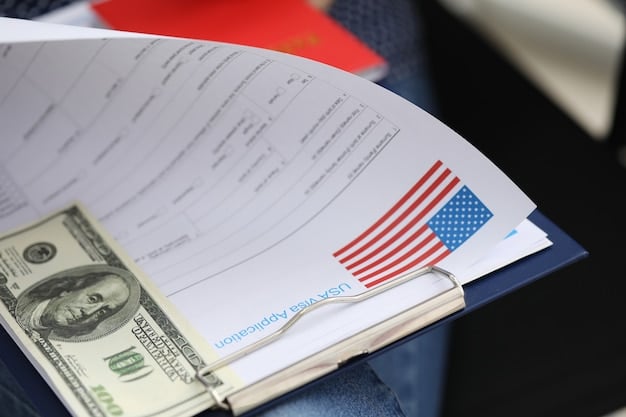Federal Student Loan Forgiveness: Latest Updates and Eligibility Criteria

Federal Student Loan Forgiveness programs offer eligible borrowers a chance to have their student loan debt partially or fully canceled, providing financial relief and a fresh start.
Navigating the complex landscape of federal student loan forgiveness can be daunting. This article provides the latest updates and eligibility criteria to help you understand your options and potential benefits.
Understanding Federal Student Loan Forgiveness Programs
Federal student loan forgiveness programs offer a pathway for borrowers to have their remaining student loan balance canceled after meeting specific requirements. These programs are designed to alleviate the burden of student debt for individuals working in public service or facing financial hardships.
Types of Forgiveness Programs
Several federal programs offer student loan forgiveness, each with its own set of requirements and benefits. Understanding these differences is crucial for identifying the best option.
- Public Service Loan Forgiveness (PSLF): For those employed by government organizations or qualifying non-profits.
- Teacher Loan Forgiveness: Available to qualified teachers working in low-income schools.
- Income-Driven Repayment (IDR) Forgiveness: After a specified period of qualifying payments under an IDR plan.

Eligibility Criteria Overview
Each forgiveness program has specific eligibility criteria that borrowers must meet. These criteria typically relate to employment type, loan type, and repayment plan.
For example, PSLF requires 120 qualifying monthly payments while working full-time for a qualifying employer. Teacher Loan Forgiveness requires five complete and consecutive years of teaching service in a low-income school. IDR forgiveness has varying timeframes based on the specific IDR plan.
In conclusion, federal student loan forgiveness programs provide a crucial lifeline for many borrowers. Knowing the types of programs and their eligibility requirements is the first step toward potential debt relief.
Latest Updates on Student Loan Forgiveness Initiatives
The landscape of student loan forgiveness is constantly evolving, with new initiatives and policy changes frequently announced. Staying informed about these updates is essential for borrowers seeking relief.
Recent Policy Changes
In recent years, there have been several significant policy changes impacting student loan forgiveness programs. These changes aim to expand eligibility, streamline application processes, and correct past administrative errors.
One notable change is the limited PSLF waiver, which allowed borrowers to receive credit for past payments that previously did not qualify. Another is the introduction of the Saving on a Valuable Education (SAVE) plan, an income-driven repayment plan designed to lower monthly payments and offer faster forgiveness.
Impact of Court Decisions
Court decisions can also have a major impact on student loan forgiveness programs. Legal challenges can lead to the suspension or termination of certain initiatives, creating uncertainty for borrowers.
For instance, the Supreme Court struck down President Biden’s broad student loan forgiveness plan in 2023, preventing the cancellation of up to $20,000 in debt for millions of borrowers. This decision underscored the importance of understanding the legal and political context surrounding student loan relief efforts.

Future Outlook
The future of student loan forgiveness remains uncertain, with ongoing debates about the role of government in addressing student debt. Borrowers should stay informed about potential policy changes and explore all available options for managing their loans.
Advocates continue to push for broader forgiveness measures and reforms to existing programs. However, the path forward will likely depend on political and legal developments. Concluding this section, keeping abreast of updates is key to navigating student loan forgiveness effectively.
Detailed Eligibility Criteria for Key Forgiveness Programs
Understanding the specific eligibility requirements for each loan forgiveness program is crucial. Here’s a closer look at the criteria for the most popular programs.
Public Service Loan Forgiveness (PSLF)
PSLF is designed for individuals working in public service. To qualify, borrowers must be employed full-time by a government organization or a qualifying non-profit.
Qualifying employment includes positions in federal, state, local, and tribal government, as well as certain non-profit organizations that provide public services. The borrower must also have Direct Loans and repay them under an income-driven repayment plan. Crucially, you need to have made 120 qualifying payments.
Teacher Loan Forgiveness Program
The Teacher Loan Forgiveness Program offers forgiveness to qualified teachers who have served for five complete and consecutive academic years in a low-income school or educational service agency.
Eligible teachers can receive up to $17,500 in forgiveness, with higher amounts available for those who taught mathematics, science, or special education. The loans must have been made before the end of the five academic years of qualifying teaching service. This can greatly help teachers who decide to remain for the long term.
Income-Driven Repayment (IDR) Forgiveness
IDR plans offer forgiveness after a specified period of qualifying payments, typically 20 or 25 years, depending on the plan. These plans are designed to make monthly payments affordable based on income and family size.
- SAVE Plan: Offers the lowest monthly payments and faster forgiveness for many borrowers.
- Pay As You Earn (PAYE): Caps monthly payments at 10% of discretionary income.
- Income-Based Repayment (IBR): Payment amounts are based on income and family size, but can be higher than PAYE.
Choosing the right IDR plan is essential for maximizing forgiveness benefits. In summary, eligibility varies significantly among these programs. Therefore, borrowers should carefully review the requirements to determine the best fit.
How to Apply for Federal Student Loan Forgiveness
Once you’ve determined that you meet the eligibility criteria for a forgiveness program, the next step is to apply. The application process can vary depending on the program.
Application Forms and Documentation
Most forgiveness programs require borrowers to submit an application form and supporting documentation. The specific forms and documents needed will depend on the program.
For PSLF, borrowers must submit the PSLF Employment Certification Form to certify their employment. For Teacher Loan Forgiveness, teachers must submit the Teacher Loan Forgiveness Application. IDR forgiveness is typically automatic after meeting the required number of qualifying payments, but borrowers may need to recertify their income annually.
Step-by-Step Application Process
To apply for PSLF, follow these steps:
- Complete the PSLF Employment Certification Form.
- Have your employer certify the form.
- Submit the form to MOHELA, the PSLF servicer.
For Teacher Loan Forgiveness:
- Complete the Teacher Loan Forgiveness Application.
- Submit the application to your loan servicer.
For IDR forgiveness:
- Enroll in an IDR plan.
- Make qualifying monthly payments for the required period.
In conclusion, the application process requires careful attention to detail. Submitting all required documents accurately will help ensure a smooth and efficient review process.
Common Mistakes to Avoid When Seeking Forgiveness
Applying for student loan forgiveness can be complex, and borrowers often make mistakes that can delay or jeopardize their chances of receiving relief. Understanding these common pitfalls can help ensure a successful application.
Incorrect or Incomplete Applications
One of the most common mistakes is submitting an incorrect or incomplete application. Failing to provide all required information or making errors on the form can lead to delays or denial.
Therefore, borrowers should carefully review the application instructions and double-check all information before submitting. It’s also crucial to ensure that all supporting documentation is included and accurate.
Misunderstanding Eligibility Requirements
Another frequent mistake is misunderstanding the eligibility requirements for a particular program. Borrowers may assume they qualify based on incomplete or inaccurate information.
Before applying, it’s essential to thoroughly review the eligibility criteria and confirm that you meet all requirements. Contacting your loan servicer or a qualified financial advisor can help clarify any doubts or confusion.
Failing to Recertify
For IDR plans, borrowers are typically required to recertify their income and family size annually. Failing to do so can result in increased monthly payments or disqualification from the plan.
Be sure to track your recertification deadline and submit the required documentation on time. This recertification is to ensure every borrower is up to date and getting the support they require.
In conclusion, avoiding these common mistakes can significantly improve your chances of receiving student loan forgiveness. Careful attention to detail and a thorough understanding of program requirements are key to a successful outcome.
Financial Planning and Alternatives to Forgiveness
While pursuing student loan forgiveness, it is important to consider financial planning strategies and explore alternative options for managing student debt.
Budgeting and Debt Management
Creating a budget can help you understand your income and expenses, allowing you to allocate funds effectively towards student loan payments. Debt management strategies, such as the debt snowball or debt avalanche method, can also help you prioritize and pay down your loans more efficiently.
These plans entail either paying off the smallest debt first, or the debt that has the highest interest rate first. Doing this can make a big difference over the long haul.
Loan Consolidation and Refinancing
Loan consolidation involves combining multiple federal student loans into a single loan with a fixed interest rate. Refinancing, on the other hand, involves taking out a new loan from a private lender to pay off your existing student loans.
Refinancing can potentially lower your interest rate and monthly payments, but it also means giving up federal loan protections, such as access to IDR plans and forgiveness programs. These protections are important and can provide security in unpredictable scenarios.
Seeking Professional Advice
Consulting with a qualified financial advisor can provide personalized guidance on managing student debt and achieving your financial goals. A financial advisor can help you assess your options, develop a repayment strategy, and make informed decisions about loan forgiveness, consolidation, or refinancing.
In summary, student loan forgiveness is just one piece of the puzzle. Integrating it with broader financial planning and exploring alternative solutions can lead to a more secure and stable financial future.
| Key Point | Brief Description |
|---|---|
| 🎓 PSLF Eligibility | Requires public service employment and 120 qualifying payments under an IDR plan. |
| 🍎 Teacher Loan Forgiveness | Available for teachers in low-income schools after five years of service. |
| 💰 SAVE Plan | Income-driven repayment plan with lower payments and faster forgiveness. |
| 📝 Application Mistakes | Avoid incomplete forms and misunderstanding eligibility criteria. |
FAQ
▼
PSLF forgives the remaining balance on your Direct Loans after you’ve made 120 qualifying monthly payments while working full-time for a qualifying employer, such as a government organization or non-profit.
▼
Teachers who have worked full-time for five complete and consecutive academic years in a low-income school or educational service agency may qualify for up to $17,500 in loan forgiveness.
▼
The Saving on A Valuable Education (SAVE) plan is an income-driven repayment plan that offers the lowest monthly payments of any IDR plan and provides forgiveness after a specified period.
▼
The application process varies depending on the program. Generally, it involves completing an application form and submitting supporting documentation to your loan servicer or MOHELA for PSLF.
▼
Common mistakes include submitting incomplete or incorrect applications, misunderstanding eligibility requirements, and failing to recertify your income annually for IDR plans; so be cautious!
Conclusion
Understanding the complexities of federal student loan forgiveness programs is essential for borrowers seeking financial relief. By staying informed about the latest updates, understanding eligibility criteria, and avoiding common mistakes, you can navigate the application process effectively and potentially reduce your student loan burden, leading to a more secure financial future.





